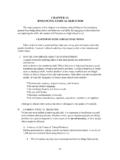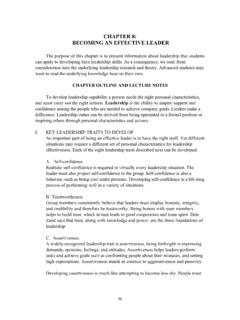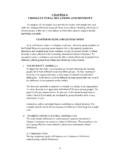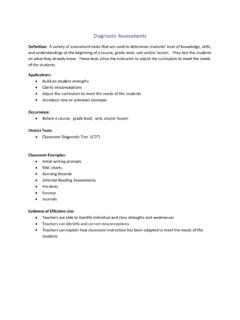Transcription of CHAPTER 2: UNDERSTANDING INDIVIDUAL DIFFERENCES
1 12 CHAPTER 2: UNDERSTANDING INDIVIDUAL DIFFERENCESA key contributor to developing effective interpersonal relationships in organizations isunderstanding INDIVIDUAL DIFFERENCES , the variations in how people respond to the same situationbased on personal OUTLINE AND LECTURE NOTESI. PERSONALITYI ndividual DIFFERENCES in personality greatly influence interpersonal refers to those persistent and enduring behavior patterns that tend to beexpressed in a wide variety of Seven Major Personality Factors and TraitsMany psychologists believe that the basic structure of human personality is represented byfive broad factors, known as the Five Factor Model. Two more key personality factors, risktaking and thrill seeking, and self-monitoring of behavior, had received much attention andare also included here.
2 All seven factors have a substantial impact on interpersonalrelations and job performance. Recent evidence has emphasized the contributions of genes,and strips of DNA in particular, in forming personality. The gene biases the mind to reachto similar experiences in different ways. Despite the genetic influence, most people canimprove their standing on key personality Neuroticism refers to emotional instability and identifies people prone topsychological distress and coping with problems in unproductive reflects the quantity or intensity of social interactions, the need forsocial stimulation, self-confidence, and reflects the proactive seeking of experience for its own reflects the quality of one s interpersonal reflects organization, self-restraint, persistence, and motivationtoward attaining of behavior refers to the process of observing and controlling howwe are perceived by taking and thrill seeking refers to the propensity to take risks and pursue on the job.
3 Any one of the preceding personality factors can be important for success. Conscientiousness relates to job performance for many different occupations. Arecent meta-analysis concludes that high self-monitoring is associated with higherperformance appraisals and more growth into management positions. The Five FactorModel (Big Five Factors) appears to apply to personality structures in different Psychological Types and Cognitive StylesPersonality also influences a person s cognitive style, or mental processes used to perceiveand make judgments from information. The information presented here is the basis for theMyers-Briggs Type information. Sensation-type individuals prefer routine and order, andsearch for precise details when gathering information to solve a individuals prefers an overall perspective, and dislike routine.
4 They wouldprefer to look for possibilities rather than work with information. Styles of information evaluation range from an emphasison feeling to an emphasis on thinking. Feeling-type individuals have a need toconform and adapt to the wishes of others. Thinking-type individuals rely onreason and intellect to deal with problems, and downplay The Four Cognitive StylesThe two dimensions of information gathering and evaluation are combined to produce afour-way classification of cognitive (or problem-solving) styles: sensation/thinking,intuitive/thinking, sensation/feeling, and intuitive/feeling. Exhibit 2-2 illustrates how thefour cognitive styles relate to occupational Guidelines for Dealing with Different Personality TypesTo match one s approach to dealing with a given personality type, a person must first arriveat an approximate diagnosis of the INDIVIDUAL s personality.
5 Fourteen suggestions arepresented in the text, yet they must be regarded tentatively. Four of these suggestions are:(1) When relating to an extraverted INDIVIDUAL , emphasize friendliness and warmth; (2)when relating to an introverted INDIVIDUAL , move slowly, and tolerate silence; (3) whenrelating to a disagreeable person, be patient and tolerant; and (4) when relating to aconscientious person, grant freedom and do not nag. ABILITYM ental ability is one of the major sources of INDIVIDUAL DIFFERENCES that affects job performance and behavior. Intelligence is the capacity to acquire and apply problems can best be solved by intelligent workers. UNDERSTANDING theintelligence of others can improve one s ability to relate to Components of Traditional IntelligenceIntelligence consists of a g (general) factor along with s (special) factors that contributeto problem-solving ability.
6 The g factor helps explain why some people perform so well inso many different mental tasks. The following seven mental ability factors have beenconsistently comprehension: UNDERSTANDING the meaning of words and fluency: the ability to use words quickly and : the ability to handle : the ability to visualize forms and objects in three : having a good rote speed:the ability to perform tasks requiring visual reasoning:the ability to discover a rule or principle and apply it to Practical IntelligenceTo overcome the limited idea that intelligence mostly involves the ability to solve abstractproblems, the concept of the triarchic theory of intelligence has been proposed. Theanalytical subtype is the traditional intelligence needed for solving difficult problems.
7 Thecreative subtype is the type of intelligence required for imagination and combining thingsin novel ways. The practical subtype is the type of intelligence required for adapting toyour environment to suit your Multiple IntelligencesAccording to the theory of multiple intelligences, people know and understand the worldin distinctly different ways, and learn in different ways. The eight intelligences, orfaculties, are as follows: (1) linguistic, (2) logical-mathematical, (3) musical, (4) spatial,(5) bodily/kinesthetic, (6) intrapersonal, (7) interpersonal, and (8) Emotional IntelligenceHow effectively people use their emotions has a major impact on their success. Emotionalintelligence refers to qualities such as UNDERSTANDING one s feelings, empathy for others,and the regulation of emotion to enhance living.
8 The five key factors of emotionalintelligence (passion for work and resiliency) skillsEmotional intelligence incorporates many of the skills and attitudes necessary to achieveeffective interpersonal relations in Guidelines for Relating to People of Different Levels and Types of IntelligenceSeveral suggestions are given for relating differently to people of different types and levelsof intelligence. For example, when people are brighter, present ideas in more technicaldepth, use more difficult words, and ask challenging questions; do the opposite with amentally slow AS A SOURCE OF INDIVIDUAL DIFFERENCESA value refers to the importance a personal attaches to something, and values are anothersource of INDIVIDUAL DIFFERENCES . Values are closely tied in with ethics, the moral choices aperson makes.
9 DIFFERENCES in values among people often stem from age, or generationaldifferences. Table 2-1 presents stereotypes about Baby Boomers versus members ofGeneration X and Generation How Values are LearnedOne important way in which we learn values is through observing others, or can be parents, teachers, friends, brothers, sisters, and even public figures. Anotherway in which values are learned is through the communication of Clarifying Your ValuesValue-clarification exercises ask you to compare the relative importance you attach todifferent objects and activities. Self-Assessment Quiz 2-3 provides insight into The Mesh Between INDIVIDUAL and Job ValuesWhen INDIVIDUAL and job values are congruent, job performance is likely to be the demands made by the organization or a superior clash with the basic values ofthe INDIVIDUAL , the person suffers from person-role Guidelines for Using Values to Enhance Interpersonal RelationsValues are an important driver of interpersonal effectiveness.
10 One approach would be toestablish the values a person will use in relationships with others on the job, and then usethose values as a firm guideline in working with others. Also, express your concern toemployers when you believe that your values are being TO DISCUSSION AND REVIEW QUESTIONS1. Why is responding to INDIVIDUAL DIFFERENCES considered to be the cornerstone ofeffective interpersonal relations?Responding to INDIVIDUAL DIFFERENCES is so important because the opposite is to relate topeople mechanically and reflexively. When a person adapts to another person suniqueness, good rapport is the likely How can knowledge of personality factors help a person form better interpersonalrelationships on the job?A knowledge of key personality factors can help people individualize their approach toother people.













